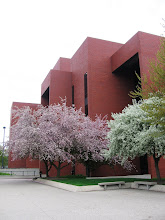Ball State University Libraries Use New Technologies to Connect with Students, Faculty
Ball State University Libraries applies several metrics to determine quality, breadth, and appropriateness of current and proposed services offerings. Hence, when Steven Abrams, SirsiDynix’s Vice President of Innovation, presented his Webinar on November 14, 2006, 25 Technologies in 50 Minutes, we took note.
Readers can download a podcast or PDF at Abram’s Lighthouse, a blog for library professionals, www.sirsidynixinstitute.com/archive.php.
Stephen highlighted current and emerging technologies that he feels may be useful in libraries. We compared his list with technologies we are actively using or that are being tested for use in Ball State’s University Libraries.
We are currently using or testing 17 of the 25 technologies identified by Stephen Abrams:
1. Real Simple Syndication (RSS) technology is used to publish and feed information from a Web site to subscribers. The University Libraries publish 10 blogs with RSS feeds enabled. Visit www.bsu.edu/library/rss.
2. Wiki technology supports group work by allowing many to add, update, and remove information from a Web site while tracking changes. The University Libraries are testing a Wiki for internal use. Visit, www.bsu.edu/libraries/wiki.
3. Blogs provide an open access Web-based publishing platform for sharing news and information about organizations, projects and initiatives.
4. Photos are technology used by the University Libraries to publish pictures of activities in the Libraries that we characterize as Life in the University Libraries, view, www.bsu.edu/libraries/viewpage.aspx?SRC=./virtualpress/photos/index.html.
5. Photo Blogs are technology that is not currently used by the Libraries.
6. Tags are technology used in resources like flickr to relate like items together. The Libraries are not currently using this technology.
7. YouTube technology is being considered for use by the Libraries.
8. MP3 technology is a file format for audio files and is being used by the Libraries for several audio assets, including podcasts, on the University Libraries’ Web site.
9. Streaming Media is a technology on which the University Libraries rely heavily to deliver digital video and audio through the Digital Media Repository (DMR), http://libx.bsu.edu, a project of the University Libraries.
10. Google Office is technology not currently used by the Libraries.
11. Instant Messaging is used in the University Libraries’ virtual reference program with library customers and as an administrative and unit level communication tool.
12. Meebo, Trillian, and GAIM technology are used in the Libraries’ virtual reference services and intra-library communication by some personnel.
13. Visualization is technology not currently used by the Libraries.
14. Second Life is technology not currently used by the Libraries. Second Life is located at http://secondlife.com and requires users to create a membership and download and install a program.
15. Avatars are technology not currently used by the Libraries. Avatars are online characters representing someone or something.
16. Retrievr is technology not currently used by the Libraries. View http://labs.systemone.at/retrievr to use retrievr to search by sketching instead of typing.
17. Podcasting is technology used by the Libraries for posting audio files on the Libraries’ Web page.
18. MySpace is a social networking website that features several Web 2.0 technologies, including an interactive, user-submitted network of friends, blogs, groups, photos, music, and videos, and more. The University Libraries have a MySpace presence and about 520 friends. View, www.myspace.com/brackenlibrary.
19. Facebook is a social networking website. The Libraries is not currently using this technology.
20. Skype technology is a voice over IP telephony application. This technology is not currently used by the Libraries although some staff are experimenting with it.
21. LibraryThing allows individuals to catalog an assortment or collection of books or other materials and share access to that catalog. Several librarians in the University Libraries are users of this application and are thinking about ways to use it to benefit our students and faculty.
22. Endeca technology is not currently used by the Libraries.
23. Virtual Reference services are implemented via Trillian software chat and e-mail.
24. Folksonomies and TagClouds are technologies developed for special Web applications to provide better results to searches.
25. Blinkx and Singingfish are technologies not currently used by the Libraries. Blinkx, www.blinkx.com, and Singingfish, www.singingfish.com, are sites that index online video. Blinkx claims to provide access to seven million hours of online video content.
In addition to these 25 technologies, The University Libraries are actively using the following Forward Facing Technologies:
· CONTENTdm is the foundation for the Digital Media Repository, a project of the University Libraries, http://libx.bsu.edu
· GIS media tools including ESRI software ArcGIS 9.1, GeoMedia Professional 5.1, and a large format color plotter
· ILLiad, Odyssey, and Ariel software are used for Interlibrary Loan lending and borrowing
· Mobile Technologies for small screen, smart devices, www.bsu.edu/libraries/mobile
· OCLC’s WorldCat and FirstSearch services.
· SFX context sensitive linking is implemented as Find It @ BSU at the University Libraries.
· Search engines, such as zuulu.com
· SirsiDynix Unicorn Integrated Library System implemented as our online public catalog, CardCat, and Media Finders developed to enhance public catalog searching
· Vendor Technologies, e.g., Blackwell Collection Manager, LARS Z39.50 client interface by Heckman Bindery


0 Comments:
Post a Comment
<< Home